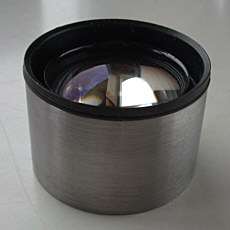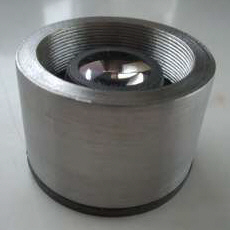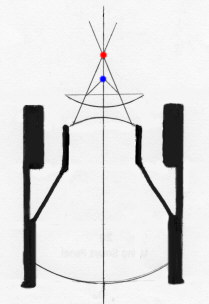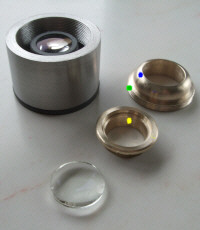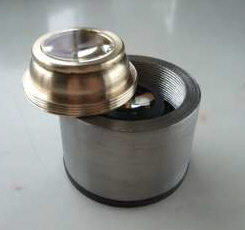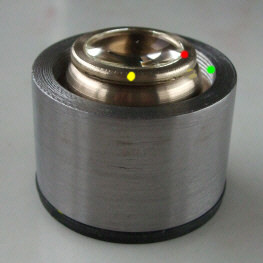| A
Seamless Wide Field Substage Condenser (part 1)
A gem conjured from the scrap heap By Paul James. |
For a very long period the general emphasis of compound microscope evolution has undoubtedly favoured its prowess at the upper limits of resolution. This in principle is entirely understandable, as well as the Kudos generated from the top draw manufacturers throughout the first three quarters of the 1900's. So in one way at least its basic design was crafted and perfected around the high power end of the amplification spectrum. Nothing has changed regarding the basic shape and size of the brightfield microscope since then. However a cursory inspection of a typical stand wouldn't reveal anything untoward regarding its design, but there is nevertheless a major weakness there.
If I had to criticise any aspect of the compound microscope's design it would undoubtedly concern the substage illumination, and most particularly the condenser. Having lost sight of an unknown yet uniquely exquisite specimen of Actinosphyr during one observing session because of the inefficient meddling required from an antiquated substage system, I decided to make changes below decks. This wasn't the first time I'd lost touch with an intriguing critter after a mobster rotifer wreaked havoc by elbowing its way through my field of view. The frustrating situation of using a superb compound microscope with its super efficient objective parcentricity and parfocality and high quality optics etc, etc; has a major operational flaw: its substage condenser's field coverage doesn't extend to the low power objectives it sports on its turret! This has been an unresolved situation that is rife throughout the industry resulting from a combination of a bias in microscopy towards high NA resolution and the difficulties of manufacturing a compound microscope which by necessity had to be fairly compact to maximise sales and therefore justify manufacturing in the first place. This issue of size doesn't affect any component on a typical 'scope above stage, but it cramps matters below it. In order to fulfill all the prerequisite conditions of ideal illumination for all the objectives, the lamphouse and condenser would be much larger than that found in a typical stand........so would the cost! Hence we are left with the compromise. I think it's also true that the onrush in general microscopy advances over the years was naturally biased toward perfecting the high NA end of imaging, leaving the lower image scaling, the 'lack lustre' end of microscopy, to its own devices over a century ago. This has cemented low power microscopy firmly into second place. So we are left with the classic situation of having to remove the condenser's top element to widen the field, though the rest of the modern 'scope is undeniably a slick performer! Supplementary optics that swing into action beneath the condenser help, but they are no substitute for an all embracing substage condenser.
Rationalising Needs
Naturally the answer to the question of what is really important below stage to individual observers will vary. I particularly wanted a substage optic which would illuminate the entire fields of 4 - 5x objectives: Wild Plan Fluotar's x3,x6,x10,x20,x40 without having to fiddle about with the condenser in any distracting way, and so keeping my eyes on the quarry at the critical moments ,and still be able to switch to the lower power objectives if need be to find the wayward specimens without losing sight of them............... parfocality and parcentricity accepted of course.
The traditional Achromat/Aplanat condenser designs cope well with the high end of numerical aperture requirements of around 0.5-1.4 NA. But their field width is usually restricted to the x10 objective at best, simply because the focal length of the immersion condenser and the 1.0 NA dry examples for that matter are short......less than 10mm . I didn't need this high NA bias for general aquatic observations, so a larger focal length condenser optic would suffice which would inherently project a larger image of the lamphouse's field source. I was in effect moving the goal posts so I could accommodate the field requirements of the midrange and low power objectives with a single condenser.
The Find
My long held desire of making a more user friendly condenser turned into reality when I stumbled across a discarded lens which turned out to be almost ideal for what I'd imagined a practical low to medium condenser should be. This 4 element coated optic fully illuminated my x3 objective with a very evenly illuminated field right to its edge, and well beyond for that matter. It was just what I'd wanted...at long last I'd found the basis of a fine achromatic low to medium power condenser! ( This lens might be one half of a camera lens combo or indeed a projection optic. It is relatively modern having its elements mounted in a tiered plastic mount. its effective focal length is roughly 25mm. )
Beginning with a simple Mount
After realising its potential I made a simple cylindrical mount from mild steel in the lathe, and finished it off with the standardised 39.5mm outer body diameter. Its interior was bored to allow the ex 'projection' lens a firm push in fitting from below, and a thread cut into the upper half which would facilitate the installation of additional lenses I might consider necessary at a later time :-
|
|
|
In Use
Through the phase 'scope I could assess its virtues and limitations easily enough, and also see any undesirable flaws in its performance. With the lamphouse's field iris diaphragm focussed in the field of view this 'new' condenser's maximum NA was soon revealed to be a tad less than my Wild x10 plan fluotar's 0.25NA. There was no visual indication that spherical aberration was compromised in any of the objective's fields, and the lamphouse field iris's edge appeared quite well defined and any spurious colour subdued...... characteristics resembling those of an achromatic/aplanatic condenser.
Subjectively speaking, this oddball optic was a joy to use. The lack of an internal iris diaphragm wasn't a problem at all, as I could attach one later should it seem necessary. It satisfied all I could wish for in a substage condenser in this range of powers in the course of general aquatic observations in all respects, and especially much needed depth of field . Most of all I liked this condenser's very subtle rendition of specimens where there was just the hint of circular cross lighting with the x3 objective , eliciting a subtle sense of relief across the entire specimen. Therefore contrast was slightly improved and overall definition enhanced too. There was some restriction of aperture when the x 20 0.45NA objective was used, but this would be my default setting anyway to improve dof in aquatic observation sessions. So far so good.
The Dust Settles
I gave myself plenty of time to get acquainted with this novel optic, and then of course I couldn't help wondering if I could increase its NA slightly without compromising its field coverage significantly. This would bolster the x40 objectives imagery. The situation was quite simple in principle : The focal length of the condenser governed the diameter of the lamphouse's field image, and since I had more than sufficient field coverage anyway for the lowest power objective (x3) I could place a suitable plano concave lens immediately above the condenser's top optic :-
|
|
The effect of the placement of the top lens is illustrated in principal in the sketch above. Since the ascending rays would be newly focussed to a nearer plane than had occured originally, the light cone's NA would be noticeably increased whilst the condenser's effective focal length would be reduced somewhat. I'd luckily possessed an ideal plano convex candidate, so I temporarily supported this lens over the condenser body and donned the phase 'scope into action.
The condenser's ouput rose to a very satisfying 0.38-0.4 NA, as gauged by the phase 'scope's view of the output from the Wild plan Fluotar's x 20 0.45 NA objective. But as expected the field coverage for the x3 objective was a tad compromised simply because the condenser's effective focal length was shortened by this additional lens. Despite this compromise, the field could be broadened easily by racking up the condenser about 10-15mm without affecting image quality of the x3 objective, which isn't in the least sensitive to any anomalies from an imperfectly positioned condenser. So far even better!
The Final Assemblage
I mounted the top plano-convex lens in a separate ring which was a close fit in the mid section assembly, which itself was externally threaded and would therefore have the potential of vertical adjustment as well as being secured to the main condenser body :-
|
|
|
..
|
|
Above...... Epoxy resin was used to bond the top lens into its circular rebate . The idea of using a separate housing for the top lens enabled, if necessary further experimentation with other lenses. The top lens is shown at its optimum vertical setting above the ex projection lens.
Concluding thoughts
It is now so convenient to be able to employ any one of x3,x6,x10,x20,x40 objectives during my searching through the aquatic world without recourse to the once time consuming fumbling below stage. The eyes can be left concentrating over the binocular head whilst the hands can instinctively change objectives and the elevation of the substage condenser without conscious thought. That lesson of losing sight of a rare and unique specimen because of the time consuming activity below stage, taught me to put lighting efficiency and convenience above all other considerations. I've now reached the point where no material extension of the field or numerical aperture can be achieved without compromise. This simple substage optic is as near to perfection as I could manage to contrive by DIY means from a couple of hours work, scrap parts and a few pennies worth of epoxy resin. But the really essential tool in all this was the phase telescope, without which the job would have taken a lot longer to accomplish. Being able to actually see the characteristics of an optic in the making quickened the whole process to its successful conclusion.
During these proceedings I started to consider the implementation of a constant brightness cross polar unit that I described last month. However I eventually settled on a very simple alternative which not only reduces anomalies in field brightness from one objective to another, but significantly enhances contrast too. This will be described and illustrated next month.
| All comments welcome by the author Paul James |
